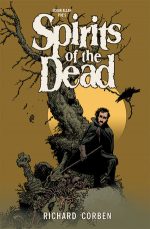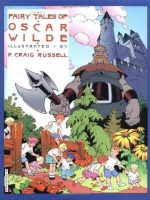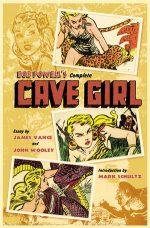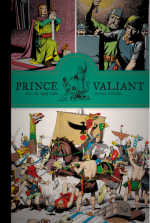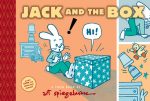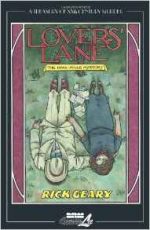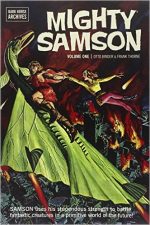
By J. Torres, Rick Burchett & Terry Austin (Archie Comics)
ISBN: 978-1-93697-500-6 (HC)Â Â Â Â Â Â Â : 978-1-87979-491-7 (PB)
Despite tremendous advances in the last decade or so, for most people, when we say comicbooks, thoughts either turn to outrageously buff men and women in garish tights or leather hitting each other and lobbing cars about, or stark, nihilistic crime, horror or science fiction sagas aimed at an extremely mature and sophisticated readership of already-confirmed fans.
For American comics these days that is indeed the norm. Over the years though (and throughout the rest of the world still), other forms and genres have continued to wax and wane.
One US company which has steadfastly held its ground against the tide over the decades – supported by a thriving spin-off TV and movie franchise – is a teen-comedy powerhouse which created a genre through the exploits of carrot-topped Archie Andrews and the two girls he could never choose between – Betty Cooper and Veronica Lodge.
For far too many years, other companies largely ignored the fact that girls read comics too and, in their frantic, slavish pursuit of the spandex dollar, lost half their potential audience. Girls simply found other ways to amuse themselves until, in the 1990s, the rise of manga painfully proved to comics publishers what Archie Comics had always known.
Ever since that pivotal moment Editors have attempted to recapture that vast missing market: creating worthy titles and imprints dedicated to material for the teen/young adult audience (since not all boys thrive on a steady diet of cosmic punch-ups and vengeful vigilantes) which had embraced European classics like Tintin and Asterix, manga material, momentous comics epics like Maus and Persepolis or the abundant and prolific prose serials which produced such pop phenomena as Twilight, The Hunger Games and Harry Potter.
Archie thrived by never abandoning its female readership and by constant reinvention of its core characters, seamlessly adapting to the changing world outside its bright, flimsy pages: shamelessly co-opting pop music, youth culture and fashion trends into its infallible mix of slapstick and romance.
Each and every social revolution has been painlessly assimilated into the mix (the company has managed to confront a number of major issues affecting the young in a manner both even-handed and tasteful over the years), and the constant addition of timely characters such as African-American Chuck and his girlfriend Nancy, fashion-diva Ginger, Hispanic couple Frankie and Maria and a host of others – such as spoiled home-wrecker-in-waiting Cheryl Blossom – all contributed to a broad and refreshingly broad-minded scenario.
There are non-sensationalised interracial romances, and in 2010 Archie jumped the final hurdle for a family-entertainment medium with the rapturously well-received introduction of Kevin Keller; an openly gay and proud young man who was a clear-headed advocate capably tackling and dismantling the last major taboo in mainstream kids’ comics.
Where once cheap, prolific and ubiquitous, comics magazines in the 21st century are extremely cost-intensive and manufactured for a highly specific – and dwindling – niche market. Moreover the improbably beguiling and bombastic genres that originally fed and nurtured comicbooks are increasingly being supplanted by TV, movies and assorted interactive games media.
Happily, old-school prose publishers and the graphic novel industry have a different business model and far more sustainable long-term goals, so the magazine makers’ surrender has been turned into a burgeoning victory, as solid and reassuringly sturdy Comics-as-Books increasingly buck the slowly perishing pamphlet/papers trend.
Publishers like Archie…
Jinx was another barely-noticed landmark which saw one of the company’s venerable and long-lived child-stars given a stunning makeover and refit courtesy of a multi award-winning creative team.
Writer J. Torres (Teen Titans Go!, Degrassi: the Next Generation, Alison Dare, Days Like This, Lola – a Ghost Story and others) in conjunction with celebrated artists Rick Burchett (Batman Adventures, American Flagg!, Blackhawk, Black Hood) & Terry Austin (X-Men, Superman, Batman, Cloak and Dagger) are responsible for turning adorable six-year old tomboy Li’l Jinx into a genuine icon of, if not role-model for, modern teenaged girls in a style and manner at once astonishingly accessible and classically captivating.
If you qualify as an Ancient One like me, you might be familiar with precocious, feisty Li’l Jinx who debuted in Pep Comics #62 (cover-dated July 1947). Created by Joe Edwards, she debuted as the publisher began dropping superheroes such as the Shield and Black Hood to specialise in kid-friendly humour features. Over the coming decades she appeared in her own title, as well as Li’l Jinx Giant Laugh-Out and assorted anthologies such as Pep and Archie Giant Series Magazine.
Like Edwards’ own son, her birthday was on Halloween and the writer/artist put much of himself into the strip. A boisterous, basically decent, sports-loving, mischievous tyke (in the manner of our Minnie the Minx), when not romping, cavorting and tussling with other kid pals Gigi, Greg, Charley Hawse, Russ, Roz and Mort the Worry Wart, Jinx almost exclusively interacted with her long-suffering dad Hap Holliday.
Her mother was seldom seen. The kid’s Christian name is lost to history: apparently so screamingly embarrassing that to utter it was to invite battered ear drums and mangled limbs…
Li’l Jinx faded away gradually during the 1980s as fashionista-teenagers and Mutant Turtles supplanted the pesky kid characters in Archie’s increasingly “young adult†oriented stable.
Jinx Holliday was revived and given a thorough 21st century upgrade for a new serial in Life With Archie (#7-11, March-June 2011); a growing girl just starting big school. The former tomboy hadn’t lost all her rough edges though…
This volume collects the serialised story of her beginning the inescapable if deplorable process of becoming responsible – with all the scary changes that entails…
After a handy ‘Cast of Jinx’ page, the dramatic comedy (available in both paperback and hardcover editions) opens with 4-part tale ‘Little Jinx Grows up’ – as serialised in Life With Archie – with the nervous Californian 14-year old starting at Rose Valley High School where she immediately falls foul of draconian martinet Principal Mr. Vernon.
At least many of her oldest friends are starting too, but they all seem so changed and grown up since summer vacation…
As they settle in, Jinx is oblivious to the fact that more than one of the boys she used to wrestle and play football with now treat her differently…
She’s just starting to hate the place and its stupid rules when Greg points out the final straw: Freshman Baseball – in fact all her favourite sports – are for boys only. Former child model Gigi is typically smug about it, hinting again that it’s time Jinx began acting like a girl, but that only provokes the incensed tomboy to break another rule…
Everybody is talking about Jinx after she extremely publicly signs up for Football Tryouts, and neither a barracking from Mr. Vernon or some heavy-handed bullying of Greg by the senior Football squad can change her mind.
The Principal thinks he has the final word after making Jinx take a permission slip home to her dad, but after Hap Holliday absolutely refuses to let his little girl get crippled by teenaged Neanderthals, Jinx simple forges his signature…
The tryouts are a disaster, but at least Greg is honestly trying to help her. Surly Charley, however, delivers a tackle that results in her being stretchered off, and when dad is called to school all hell breaks loose…
While she’s grounded and recovering, BFF Roz starts dropping hints about Greg and romance, promptly going into snoopy overdrive when a mystery caller leaves a large bouquet of flowers…
For the first time Jinx realises High School is just one big stew of frustrated hormones which only adds to her worries. So preoccupied is she that, when Greg timidly asks her to a dance, she doesn’t realise what he’s saying and shoots him down without even noticing. The mystery flower-sender – covertly watching – does, however, and seethes…
Flustered, confused and determined to end the turmoil in her head, Jinx then ambushes and pre-emptively kisses Greg, but the result is something neither of them nor their secret stalker expected…
The grand gesture completely destabilises Jinx who goes into a spiral of angry depression and tetchy acting-up. Baffled Hap is hopeless to cope, and, with Halloween approaching, throws himself into organising her birthday costume party: a tradition they’ve enjoyed since she was a toddler. He has no idea how much his little girl has changed and that the prospect of a party sounds like torture to her…
And thus the scene is set for a showdown nobody will ever forget…
All dramatic foreboding aside, this clever, warm tale ends well and promises much more for the future. Smart, witty and intoxicatingly engaging, Jinx is a superb example of what can be accomplished in comics if you’re prepared to portray modern kids on their terms and address their issues and concerns.
Without ever resorting to overblown soap melodrama or angst-ridden teen clichés, Torres has delivered a believable cast of young friends who aren’t stupid or selfish, but simply trying to find their own tentative ways to maturity. The art by Burchett and Austin is semi-realistic and mesmerisingly effective.
This terrific turbulent tome includes many bonus features such as a ‘Football Pinup’, J. Torres’ thoughts and commentary on the story as described in ‘The Voice of Jinx’ and a fascinating, picture-packed peek behind the scenes in ‘The Concept Art of Jinx’.
More production secrets are revealed by Editor Suzannah Rowntree, describing how the project was conceived and created in ‘The Story of Teen Jinx’ and there’s even a smart selection of one-page Short Comics treats to wrap up the fun.
‘Fitting In’, ‘It’s Complicated’, ‘Frenemy of the State’, ‘The Dating Game’ and ‘Chat Fight’ all combine to prove that although they might be growing up, the cast are still kids at heart…
Compellingly funny, gently heart-warming and totally absorbingly, this book will resonate with kids and parents, offering genuine human interactions rather than repetitively manufactured atom-powered fistfights to hold your attention. It especially gives women a solid reason to give comics another try.
Sheer exuberant fun; perfectly crafted and utterly irresistible…
© 2012 Archie Comics Publications, Inc. All rights reserved.

